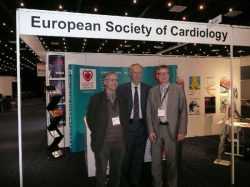Fighting acute coronary syndrome
Today in most countries of the world almost 50 % of patients in hospital for a cardiac condition began their treatment as emergency cases: chest pain at home . . . a cardiac arrest in the street. Thus, according to Dr Peter Clemmensen, of the 22 million hospital admissions in Europe each year for acute cardiac events, more than 10 million of them would have begun as an emergency and without warning.


"Early diagnosis is crucial in these cases for successful treatment and survival," he says, describing acute coronary care as “the most challenging field of cardiology”.
Such events - evident as chest pain or at worst a cardiac arrest - are invariably the prelude to one of the most critical episodes of health care. Acute cardiac care, that first emergency phase in which the event is assessed and its cause treated, embraces a broad spectrum of diagnoses ranging from unstable angina to acute heart failure, from myocardial infarction to other life-threatening disorders of the heart.
Dealing with these cases - and importantly as quickly as possible - is the theme of Acute Cardiac Care 2010, this year's congress of the ESC's Working Group on Acute Cardiac Care, which takes place in Copenhagen from 16-19 October.
According to Dr Clemmensen, local chairman of this year's Acute Cardiac Care, foremost among the challenges addressed at the congress will be the speed at which accurate diagnosis can be made using telemedicine, the risk-benefit analysis of early reperfusion therapy, and the provision of intensive coronary care units.
1. Diagnosis as early as possible
While there has been progress in improving overall mortality rates following acute myocardial infarction (AMI), survival rates when the arrest takes place outside hospital are poor - and no better than 5 per cent in some European countries. The key to improving survival rates are early and accurate diagnosis; once in hospital and undergoing acute cardiac care, patients have a much better chance of survival.
So, much depends on immediate intervention, which can be much more efficiently introduced if diagnosis can be made in the ambulance. "Two-thirds of European ambulances are now able to transmit digitalised ECG recordings," says Dr Clemmensen. “If we can reopen the occluded arteries - by angioplasty, surgery or thrombolysis - within the first hour, we can usually prevent damage to the heart muscle and improve the chance of survival. Timing is crucial, so we'll be considering at the congress how a more efficient paramedical service with telemonitoring ECG can shorten the time delay between the onset of symptoms and treatment."
2. The risk-benefit of early thrombolytic therapy
The latest ESC guidelines on the treatment of acute coronary syndromes emphasise the importance of therapies to prevent thrombosis and maximise the effect of other treatments (PCI, percutaneous coronary intervention with balloon angioplasty and stent, or coronary artery by-pass surgery). However, it is now clear that the administration of some of these antithrombotic treatments is also associated with a high risk of gastric bleeding. The guidelines state: "Since the vast majority of PCI procedures eventually conclude with stent implantation, every patient scheduled for PCI should be considered for pre-treatment with clopidogrel, regardless of whether
stent implantation is intended or not." However, therapies like clopidogrel or prasugrel are also associated with a risk of (gastric) bleeding and a variation in response. "This is important," says Dr Clemmensen, "and the congress will consider the most effective dose and the most effective treatment for each individual patient. There's a delicate balance between beneficial effect and risk of bleeding." Finding a way to find this balance remains a major challenge in acute coronary care.
3. Intensive care units
Surveys indicate that there is a shortage of intensive coronary care beds in European hospitals. One in 20 patients admitted to hospital with an acute coronary syndrome are in a state of "cardiogenic shock", a condition in which the heart fails to pump adequately and which is the leading cause of death for acute heart attack patients. Again, PCI is the standard treatment, but these patients, says Dr Clemmensen, are most efficiently treated in intensive care units. Several presentations at the congress will consider the most effective way of dealing with patients with cardiogenic shock and in less than ideal circumstances.
Acute Cardiac Care 2010 will present new data on the way acute cardiac patients are managed, particularly in accordance (or not) with the latest guidelines. There have been significant improvements in mortality rates in acute patients admitted to hospital. The challenge raised at this congress is how to improve survival rates in that short period of time between onset of symptoms and first medical contact.
18.10.2010











